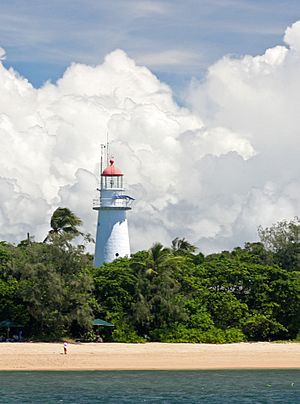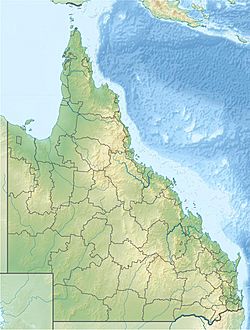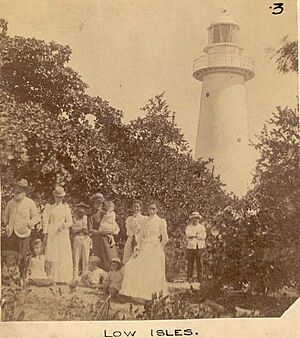Low Isles Light facts for kids
 |
|
| Low Isles Light, 2008 | |
|
|
|
| Location | Low Island Queensland Australia |
|---|---|
| Coordinates | 16°23′02.6″S 145°33′35.3″E / 16.384056°S 145.559806°E |
| Year first constructed | 1874 |
| Year first lit | 1878 |
| Automated | 1993 |
| Foundation | concrete tower |
| Construction | timber frame clad with galvanized iron |
| Tower shape | conical tower with balcony and lantern |
| Markings / pattern | white tower, red lantern dome |
| Height | 60 feet (18 m) |
| Focal height | 65 feet (20 m) |
| Original lens | Chance Brothers 3rd order (500 mm) dioptric |
| Current lens | VRB-25 |
| Intensity | 49,212 cd |
| Range | 17 nautical miles (31 km; 20 mi) |
| Characteristic | Fl W 10s. |
| Admiralty number | K3194 |
| NGA number | 111-9896 |
| ARLHS number | AUS-102 |
The Low Isles Light, also called Low Islets Light or Low Island Light, is a working lighthouse. It stands on Low Island, a small coral island. This island is part of the Low Isles group, found about 13 kilometres (8.1 mi) northeast of Port Douglas in Queensland, Australia.
The lighthouse is important for ships. It sits on the edge of the main shipping path into Port Douglas. It helps guide ships safely into the harbour. Built in 1878, it was the very first lighthouse in Far North Queensland. It was also the first to light up the Inner Passage of the amazing Great Barrier Reef.
The lighthouse was built using a common style for Queensland lighthouses back then. It has a timber frame covered with galvanized iron. This lighthouse was the fourth of its kind in Queensland. But it was the first to have portholes, which are round windows like on a ship.
The lighthouse was first suggested in 1876. Construction began more than a year later. The lighthouse and its living quarters were ready by late 1878. The original light used oil wicks. It was updated to kerosene in 1923. In 1963, it became electric. Finally, in 1993, it switched to solar power. This is when the lighthouse keepers left the station.
Low Island is quite small. So, the buildings around the lighthouse are close together in a circle. The lighthouse is the only original building left. The homes for the keepers were rebuilt in the 1960s. Today, one of these homes is used as a research station. The Queensland Parks and Wildlife Service looks after the station. You can visit the island, but you cannot go inside the lighthouse tower.
Contents
Why Was the Lighthouse Needed?
As new ports grew in northern Queensland, like Mackay (1860) and Bowen (1864), ships needed safer ways to travel. Ships coming from places like India and China had to use the Inner Passage. This path through the Great Barrier Reef was very dangerous without lights.
In 1864, a government group noticed this problem. They saw that ships were avoiding northern ports because of the risks. But no official plan for a lighthouse was made yet.
Building the Low Isles Light
In February 1876, Commander George Poynter Heath suggested building a lighthouse on Low Island. He was the head of the Queensland Marine Board. His idea was quickly approved. However, making the plans for the lighthouse took some time.
Offers to build the lighthouse were asked for in March 1877. In May 1877, W. P. Clark won the contract for £3,195. Clark had already built Queensland's first lighthouse after it became a separate colony, the Bustard Head Light in 1868. He also built other lighthouses later on.
Clark promised to finish the lighthouse and cottages in seven months. Work started in Brisbane in July 1877. By December 1877, the lighthouse parts were being moved to Low Island. The building was finished by August 1878. The light finally shone for the first time on September 17, 1878.
The lighthouse had a special lens from Chance Brothers. It was a revolving lens that made the light shine brightest every minute. Ships could see this light from 14 nautical miles (26 km; 16 mi) away. The tower was painted white. The first light source used oil wicks. It was about 13,000 cd bright. Three homes for the lighthouse keepers were also built. These homes were made elsewhere and brought to the island.
Changes Over Time
In March 1911, a cyclone hit the island. It damaged the buildings and washed away soil and plants. In 1912, an inspection suggested making the light brighter. They also wanted to change how the light flashed. And they thought a fog signal should be added.
The lighthouse became part of the Commonwealth Lighthouse Service in 1915. But it wasn't until 1923 that the light was upgraded. It started using vaporized kerosene, making it 100,000 cd bright. The way the light flashed was changed then, and again in 1930.
In 1960, two of the three keeper's homes were replaced. In 1963, the light became electric. More buildings were added that year. A new boathouse was built, and new living quarters for relief keepers. A fuel storage building was also added. In 1972, a powerhouse and a larger fuel store were built.
In 1992, the Australian Maritime Safety Authority (AMSA) decided to make the station automatic. This meant the light keepers would leave. The island would then be looked after by the Queensland Parks and Wildlife Service (QPWS). This news led to the creation of the Low Isles Preservation Society. This group wanted to protect the island and its lighthouse.
The light was changed to solar power in March 1993. As planned, the keepers left, and the QPWS took over. The old lens from the lighthouse is now on display. You can see it at the Court House Museum in Port Douglas. The last keeper left the island in 1994.
How the Light Works Today
The light now flashes white every ten seconds (Fl.W. 10s). It can be seen from 17 nautical miles (31 km; 20 mi) away.
The equipment used is a VRB-25 rotating at 1 rpm. The light comes from a 12 Volt 20 Watt Halogen lamp. It shines with an intensity of 49,212 cd.
What the Lighthouse Looks Like
The lighthouse tower stands on a concrete base. It is shaped like a cone. Inside, it has a timber frame. The outside is covered with galvanized iron plates that are riveted together. The whole tower is painted white.
Sunlight enters through portholes. To get to the top, you climb a square wooden staircase. This staircase wraps around a central tube. The landings between stairs are made of wood covered with metal. At the very top, there is a balcony. Above that is the Chance Brothers lantern room, which is 8 feet 1 inch (2.46 m) wide. This room holds the VRB-25 lantern. The balcony is made of wooden sections that stick out. It has an iron fence around it.
Other Buildings on the Island
Because the island is small, all the buildings are arranged close together. They are in a circle around the lighthouse. These buildings include two homes for the keepers. One was for the main keeper, and one for the assistant. There are also homes for relief keepers.
Other buildings include an old and a new powerhouse. There's also an old fuel storage building and a newer, larger one. You'll find a boathouse and a toilet block. The station also has a grave site, some water tanks, a landing spot for boats, and weather equipment. All these buildings have wooden frames and are covered with fibro material. The only exception is the 1972 powerhouse, which is made of brick.
The keeper's homes were built in the early 1960s. They are raised up on concrete posts. The space underneath is used for storage. You get into the homes using aluminum stairs built in 1987. Their roofs are hipped and made of fibro cement with stainless steel gutters.
The home that used to belong to the assistant keeper is now the Low Isles Research Station. It has a lab under the house. It can sleep up to six people.
Visiting the Low Isles Light
The Australian Maritime Safety Authority (AMSA) runs the light. The Queensland Parks and Wildlife Service (QPWS) owns and manages the site. It is part of the Great Barrier Reef Marine Park.
You can only get to the island by boat. Day trips to Low Isles are available from Cairns and Port Douglas. You can visit the station, but the lighthouse tower itself is closed to visitors.
The original lens from 1878 is on display. You can see it at the Court House Museum in Port Douglas.




